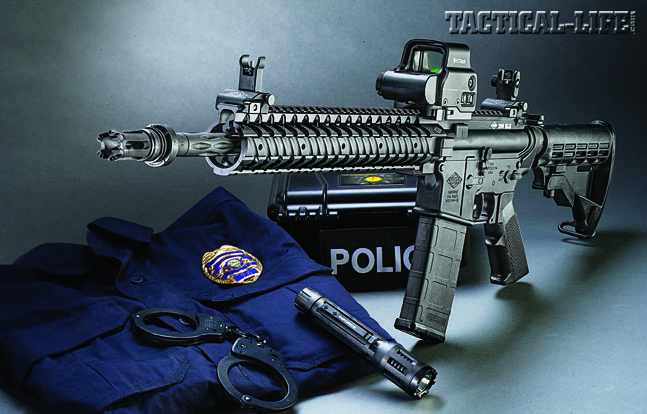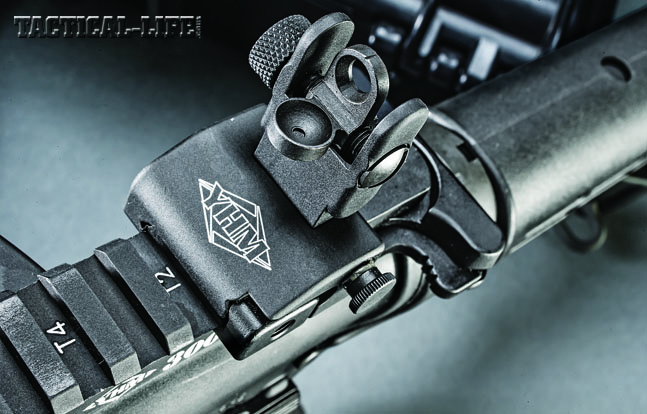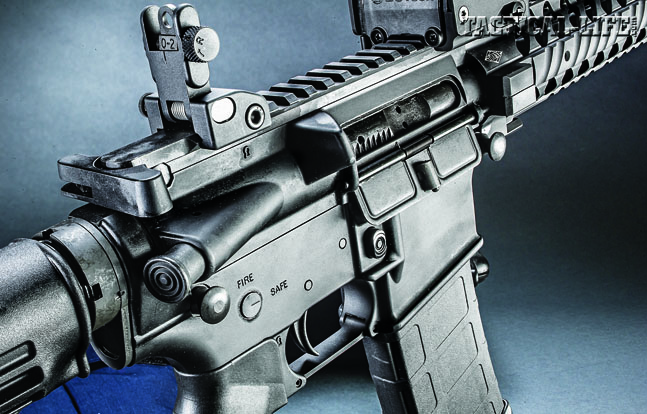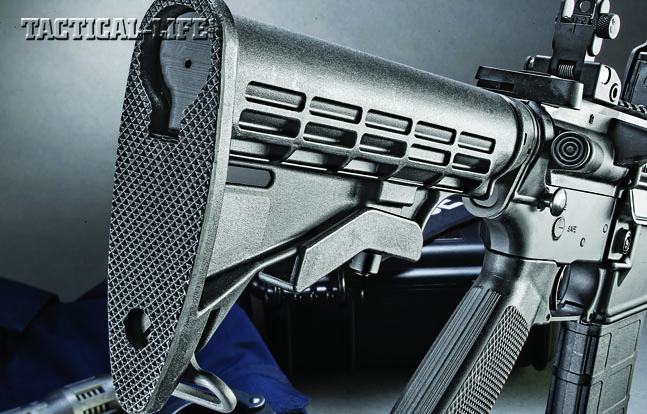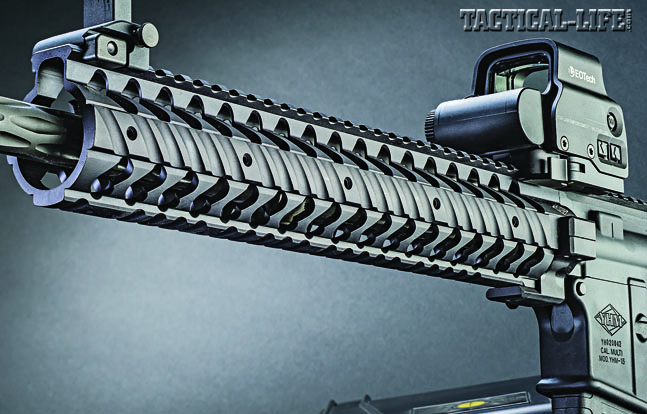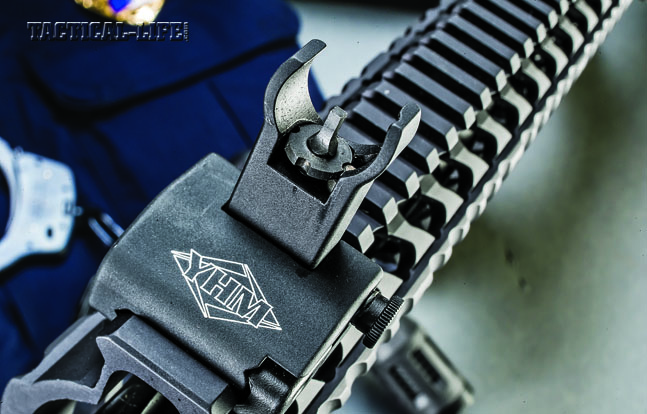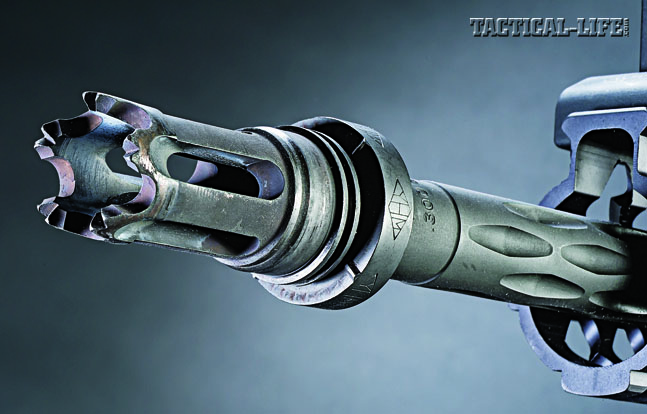Yankee Hill Machine (YHM) has been making quality parts for AR-type rifles for many years. The company’s forends first came to my attention almost eight years ago. Railed forends were new at the time, and very few were available. Some were incredibly expensive, costing almost as much as the rifles themselves. Most people were just not going to pay $300 for a quad-rail forend to put on their $700 rifles. As a workaround, some of us just bought scope rails from our local sporting goods stores and screwed them into the plastic M4 handguards.
The same was true when it came to flip-up sights. Most rifles at the time still used a fixed A2 front sight, so flip-up rear sights, a product of the “removable carry handle” found on M4 Carbines, were pretty new. Even then, some of the best cost over $200—way too much for most operators. YHM stepped in and provided high-quality alternatives at half the price, making them available for far more shooters. The company also made a few more affordable items, including rifle suppressors.
As a new Class III dealer dedicated almost solely to police officers, suppressor sales were minimal at best. While the opposite is true today, at the time, suppressors for precision rifles and carbines were a novelty outside the military. They were also rather costly. The most popular police carbine of the day was about $750. High-quality suppressors cost as much or more, and they were nowhere near as refined as they are today. Precision rifle suppressors were incredibly valuable to police marksmen, but most agencies simply could not afford them. YHM provided several quality models at affordable prices. Over the years, I have sold many YHM suppressors that are functioning well to this day. They’ve seen tons of use, and several local agencies are still deploying with them. YHM was a lifesaver to many police marksmen, and its products have only gotten better. Along with high-quality parts, the company is now building complete rifles, and getting my hands on both a rifle and suppressor provided for some great time at the range.
Advertisement — Continue Reading Below
Gun Details
YHM’s newest forend design is the SLR (Slim, Light, Railed). It is available in several lengths and two primary configurations: railed and smooth. Quad-railed versions remain narrow and lightweight, with built-in rails at 3, 6, 9 and 12 o’clock positions. Smooth models have a fixed top rail with rail attachment points along the other three positions. Rails can be attached as desired in various lengths. Customizable handguards are fast becoming the norm—most have no need for all the rail space a qual-rail affords. Smooth handguards are more comfortable and ultimately slimmer and lighter. Both SLR styles accommodate piston and direct impingement systems. Attachment requires no extra tools, and the barrel remains free floated. Hardcoat anodized, the SLRs have a really clean look and remain very comfortable to grasp.
SLR rifles will be equipped with this forend, along with other quality YHM parts. The rifle I was sent for testing was chambered in 300 AAC Blackout, or 300 BLK. Quickly becoming a favorite for duty use, this caliber is growing more popular every day. The SLR starts with the company’s YHM-15 lower receiver. Forged from 7075-T6 aluminum, it’s machined in-house, and features an enlarged magazine well and will accept any mil-spec parts. My test rifle’s lower receiver internals were all standard-issue, with the exception of the EZ Pull takedown pin set. Larger knobs allow you to pull the pins out without a tool or bullet. Rounding out the lower receiver were an A2-style pistol grip and a six-position collapsible stock.
Marked “300 BLK,” the forged upper receiver is hardcoat anodized and mated perfectly with the lower receiver. The bolt group and charging handle are standard issue. The barrel is chrome-lined and fluted with an elongated diamond pattern. The rifle has M4 feed ramps for greater reliability, and the 16-inch barrel features a 1-in-8-inch twist rate as well as 1/2-36 threading, which allows for the use of YHM muzzle devices. A quick-disconnect (QD) Phantom flash suppressor tops off the barrel. YHM also shipped my test rifle with both front and rear flip-up QDS sights (comes standard). These sights are very low profile, allowing for scopes or red dots to be attached easily.
Advertisement — Continue Reading Below
The 300 BLK cartridge is one of the easiest to suppress, and that’s what it was created for. In a rifle with a quality suppressor, it is efficient, quiet and does not suffer many of the reliability issues seen by some suppressed 5.56mm rifles. For testing, YHM supplied its new .30-caliber Phantom LT suppressor to complete the package. Weighing in at just 20 ounces, its stainless steel and Inconel construction keep it strong. With a retail price of only $789, it remains one of the most affordable on the market. And, getting it in .30 caliber allows it to be used on several rifles, adding to its versatility.
To evaluate the rifle’s handling, I mounted an EOTech EXPS3-2 holographic sight. To reach out to longer distances, I used EOTech’s G33.STS 3X magnifier with the EXPS3-2. For accuracy testing and shooting groups, I attached a Leupold 3-18x44mm Mark 6 scope.
Range Time
Match ammunition remains rare, not only in terms of build but availability. Remington’s 125-grain OTM match remains the 300 BLK standard, and it’s the only load I’ve tested so far that has accomplished true match accuracy. It has consistently provided the best groups in every 300 BLK rifle I’ve tested, and this test was no exception. The Remington 125-grain OTM ammunition produced a 0.75-inch group at 100 yards. Remington’s AccuTip round was almost as accurate. Everything grouped into 1.5 inches or less, making the YHM SLR plenty accurate for any duty environment.
Advertisement — Continue Reading Below
Most of the range testing was completed using supersonic ammunition loaded by RTBA, an ammunition company in Texas. Loaded using Barnes’ excellent Tactical M/LE 110-grain bullet, this ammunition is well suited to duty use. It has also remained available during the shortages so common these days and has always been clean-shooting, accurate and reliable.
The SLR functioned flawlessly—there wasn’t a single malfunction—and its accuracy was excellent. The SLR forend kept the rifle pretty well balanced. Its thin profile and light weight are well suited to most grips, and the SLR is perfectly suited to the latest shooting methods. The rifle’s recoil was only a little more than a 5.56mm rifle, and muzzle rise was minimal. The flash suppressor looks cool and kept the noise to a minimum. The mil-spec trigger broke cleanly and predictably.
As a rule, mil-spec magazines will feed 300 BLK ammunition without issue. Some magazines have an issue locking the bolt to the rear. This seems to be more evident with shorter barrels, and it can be just as dependent on the build. With the SLR, all of my PMAGs worked, including several Gen 2 versions. I also tried some aluminum Brownells magazines and a few other quality, mil-spec brands—all worked fine. A consistent performer in this caliber is the Lancer Systems L5 Advanced Warfighter, and mine worked perfectly in this rifle. Everything ran in this rifle, suppressed or not.
Advertisement — Continue Reading Below
Attaching the Phantom LT suppressor, accuracy at 25 yards and in was unchanged. When shooting a ton using a suppressor, you really need to keep the bolt carrier group well oiled, as you’re going to get a lot of buildup. After a couple hundred rounds, the rifle was filthy, but if I kept it wet, it still ran. Heat was noticeable after long strings, as expected, so if you shoot a lot like this, wear gloves. The SLR rail has lots of openings, so it dissipates heat well, but it will get warm. Backpressure with this can is what you would expect with a standard suppressor, but it did not adversely affect operation. Rapid fire did not seem to lock things up, and though a lot of excess gas came my way, it wasn’t much more than a 5.56mm similarly suppressed.
Final Thoughts
The only subsonic round coming close to cycling reliably was Hornady’s .300 Whisper, 208-grain A-MAX round. None of the 220-grain loads cycled with any consistency whether the suppressor was attached or not. If you are going to use subsonic ammo in a life-or-death situation, set up the rifle to use it and make sure it runs in your gun. This will generally require a spring change, and maybe an adjustable gas block.
The barrel has 1/2-36-TPI threading, which can be problematic for many who already have suppressors. YHM’s engineers felt this was a better choice for use with their QD muzzle devices, providing a better shoulder. Given that none of the major suppressor makers use this threading, however, you may have to get an adapter made or use a YHM suppressor. Most .30-caliber suppressors have 5/8-24 threading, so you will need take some steps to make yours work.
Advertisement — Continue Reading Below
Conversely, YHM makes a QD mount with 5/8-24 threads as well as most other standard configurations. You can fit this suppressor on one of the company’s flash suppressors—not only a 5.56mm AR (1/2-28) but even the 14x1mm LH threading used on your AK-47. With the Phantom LT suppressor removed, shift in impact was about an inch, but this is often very rifle dependant and seems very typical.
YHM’s SLR rifle worked well whether the suppressor was attached or not. Its accuracy was excellent, and the new SLR forend is fantastic. This rifle was well balanced, comfortable to shoot and would field well given any circumstance. Especially for a steel suppressor, the Phantom LT was pretty light. It did not make the rifle overly barrel-heavy, backpressure was about normal, shift in impact was minimal, and the price is excellent. Put the SLR rifle and Phantom LT suppressor together and you have a great package. If you are in the market for a 300 BLK rifle or suppressor (make sure you order the correct thread size), make sure you give YHM a close look. For more information, visit yhm.net or call 877-892-6533.
